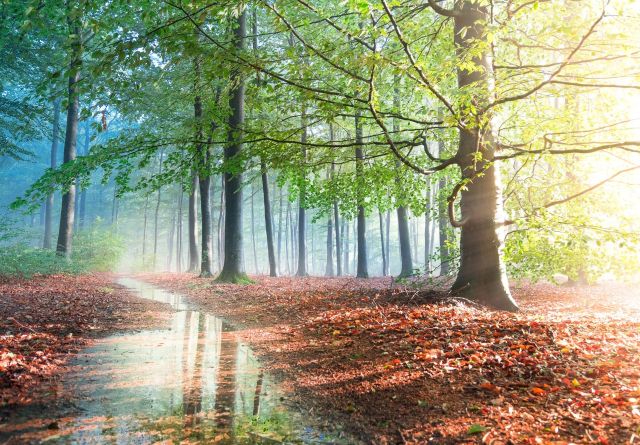
For water supply, households in Switzerland are provided with tap water from the surrounding waterworks. To do this, the waterworks treat raw water from various sources. After treatment, this raw water becomes the tap water. Depending on the region, Swiss waterworks obtain approximately 40% of their raw water from groundwater, 40% from springs, and 20% from surface water such as lakes and rivers.
The Water Cycle
Water is constantly in a continuous cycle.
Due to the effect of sunlight, water evaporates from seas, lakes, and rivers, rising into the Earth's atmosphere as water vapor. Due to the temperature difference, the water vapor condenses into water droplets, forming clouds. In the clouds, more and more water droplets accumulate through further condensation of water vapor. Once the accumulated water droplets become too heavy, they fall as rain, returning the previously evaporated water to the earth's seas, lakes, and rivers.
A large portion of the rain falls on the ground and seeps in, forming groundwater, which in turn forms lakes and rivers. At sufficiently low temperatures, as experienced in winter, the water droplets in the clouds crystallize into tiny snow crystals. These snow crystals grow in size and weight through the crystallization of additional water droplets. Once the snow crystals become heavy enough, they fall to the earth as snow, forming glaciers, for example.
Due to renewed sunlight, the water evaporates again, and the water cycle begins anew.
From Groundwater to Drinking Water
To extract raw water, groundwater is pumped to the surface and transported to the waterworks through water pipes. If the raw water for later tap water comes from springs, lakes, or rivers, it is also transported directly to the regional waterworks via pipes. The waterworks then purify the raw water and prepare it for use as tap water. After treatment, the tap water is usually first sent to a water reservoir and then to individual households.
The Quality of Swiss Tap Water
Swiss tap water is generally of very high quality and is among the cleanest and purest water in the world. This is partly because approximately 40% of tap water in Switzerland comes from spring water. Before it emerges at the spring, spring water has always seeped through several layers of humus, gravel, sand, and many rock layers, naturally filtering and purifying it to a very high degree. Additionally, Swiss waterworks are required by food law to regularly check their treated water for potentially harmful microorganisms, chemical contaminants, and other pollutants.
Excluding Possible Contaminations
According to reports from SRF, Luzerner Rundschau, the news portal Bzbasel.ch, and other reports, different regions in Switzerland sometimes find various contaminants and pollutants in cleaned tap water for various reasons.
The causes can be diverse. One weak point in the water supply network is the water pipes. All water pipes running across the country and to houses and apartments have a limited lifespan. This is also mentioned in a report on Hausmagazin.ch. Due to this limited lifespan, individual pipes in the water supply network must be regularly repaired or replaced. During these repairs and as the condition of individual pipes deteriorates over the years, there is a possibility that tap water may become contaminated or its quality may deteriorate. The responsibility for the flawless quality of tap water has been transferred by law to homeowners. Homeowners are thus required to ensure that tenants of the respective house are supplied with high-quality drinking water. Therefore, water analyses, which can also be carried out independently from time to time, are recommended. Furthermore, it is important for kindergartens, schools, and parents to ensure the impeccable quality of drinking water.
With our water analyses and quick tests, you always have the option to quickly and easily determine your water quality yourself.
Our proven test kits, quick water tests, and laboratory analysis can quickly and easily detect heavy metals, many other risk parameters, and possible contaminants in tap water, allowing you to counteract them if necessary.
